Decadal Study of Changing Frequency and Intensity of Rainfall for Selected Locations of Tamil Nadu
S. Kokilavani
*
 , SP. Ramanathan
, SP. Ramanathan
 , GA. Dheebakaran
, GA. Dheebakaran
 , N.K. Sathyamoorthy
, N.K. Sathyamoorthy
 , B. Arthirani
, B. Arthirani
 , T. Ramesh
, T. Ramesh
 , K. Sathyabama
, K. Sathyabama
 , M. Joseph
, M. Joseph
 , P. Balasubramanian
, P. Balasubramanian
 and P. Arunkumar
and P. Arunkumar
Corresponding author Email: kokilavani.s@tnau.ac.in
DOI: http://dx.doi.org/10.12944/CWE.16.3.20
Copy the following to cite this article:
Kokilavani S, Ramanathan S. P, Dheebakaran G. A, Sathyamoorthy N. K, Arthirani B, Ramesh T, Sathyabama K, Joseph M, Balasubramanian P, Arunkumar P. Decadal Study of Changing Frequency and Intensity of Rainfall for Selected Locations of Tamil Nadu. Curr World Environ 2021;16(3). DOI:http://dx.doi.org/10.12944/CWE.16.3.20
Copy the following to cite this URL:
Kokilavani S, Ramanathan S. P, Dheebakaran G. A, Sathyamoorthy N. K, Arthirani B, Ramesh T, Sathyabama K, Joseph M, Balasubramanian P, Arunkumar P. Decadal Study of Changing Frequency and Intensity of Rainfall for Selected Locations of Tamil Nadu. Curr World Environ 2021;16(3). Available From: https://bit.ly/3qtyj6q
Download article (pdf)
Citation Manager
Publish History
Select type of program for download
| Endnote EndNote format (Mac & Win) | |
| Reference Manager Ris format (Win only) | |
| Procite Ris format (Win only) | |
| Medlars Format | |
| RefWorks Format RefWorks format (Mac & Win) | |
| BibTex Format BibTex format (Mac & Win) |
Article Publishing History
| Received: | 02-07-2021 |
|---|---|
| Accepted: | 08-11-2021 |
| Reviewed by: | 
 Dr. M.C. Manjunatha
Dr. M.C. Manjunatha
|
| Second Review by: |

 Dr. Vyas Pandey
Dr. Vyas Pandey
|
| Final Approval by: | Dr.S. K. Dash |
Introduction
Water resource managers and hydrologists are now concerned about the shifting pattern of rainfall as a result of climate change4. Due to the extreme significant fluctuations in rainfall trend, drought and flood-like dangerous situations might occur often12. Rainfall intensity affects rainfall segmenting into infiltration and runoff, soil movement and the amount of water available in plant root zones to promote crop growth in agriculture6. The timing and intensity of rainfall also restrict the transport of nutrients and plant protection compounds. Agriculture has already faced a number of challenges as a result of our environmental changes14 .
Greater soil loss may occur as a result of higher rainfall intensities and many of the management options for increased climate resilience in agriculture are those that prevent soil loss and maintain soil health. On a global scale, the pragmatic intensity of daily heavy precipitation events, i.e., the amount of rain per unit time, increases at a pace similar to that of vapour pressure. (6–7% K−1). Future climate change projections also point to increasing rainfall intensity in some areas5.
Since agriculture is considered to be an important part of the Indian economy, any changes in rainfall are taken into consideration account. The influence of climate change on agriculture has an impact on the rising population's food security. For improved adaptation measures, a thorough understanding of a region's climate is required7. Climate extremes have a significant impact on crop production, resulting in food insecurity, which has a negative impact on the country's economy.
In several places of India, notably the southern peninsular region, there is a strong increase in extreme occurrences 11. The evidence of the peak rainfall intensities at the stations is instrumental for the planning of disaster management and for studying the ecological aspects pertaining to water runoffs in the locality of the stations. The rainy day's research can provide data on the frequency and severity of rain events in various meteorological conditions. When compared to periods of normal and above-average rainfall, a drought season may have fewer rain days and less rain per day. As a result, statistical characteristics of daily rainfall distribution at several sites across a large area are fascinating and significant components of rainfall climatology 9.
The most important strategy for sustainable water resource management is to research climate change, specifically on changes in rainfall occurrences and allocation. Most significantly, a thorough understanding of precipitation patterns in a changing environment would aid in better decision-making and improve communities' ability to adapt to extreme weather occurrences. The greatest impediment to successful water resource management in India is the uneven distribution of water supplies across the country due to the natural pattern of rainfall occurrence, which varies greatly in area and time2. Climate change further accelerates this rainfall variability7. In a nutshell, it's important to assess whether there's a pattern in rainfall and variability. This research gives an exploratory, regionally distributed decadal examination of rainfall variability and intensity across Tamil Nadu's several agro-climatic zones.
Data and Methodology
The daily rainfall data was acquired from the Agro Climate Research Centre, Agricultural Colleges and Research Stations, Tamil Nadu Agricultural University, Tamil Nadu, over the period 1990 to 2019 and presented in Fig 1.
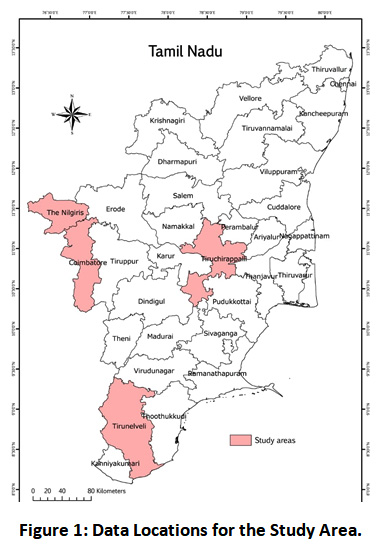 |
Figure 1: Data Locations for the Study Area. Click here to view Figure |
The data were quality checked and sliced into different time scales on the decadal period (1991-2000-I,2001-2010-II and 2011-2021- III) and converted into India Meteorological Department (IMD) prescribed seasonal period viz., Cold Weather Period (CWP), Hot Weather Period (HWP), South West Monsoon (SWM) and North East Monsoon (NEM). The per cent contribution of seasonal to annual rainfall, number of rainy days (>2.5mm per day) for the three decadal periods were analysed.
The Co-efficient of Variation(CV)was worked out to know the dependability of the rainfall for the different seasons. Based on the IMD nomenclature, the intensity of rainfall was categorized into Very Light Rain-VLR (0.1-2.4 mm), Light Rain-LR (2.5-7.5 mm), Moderate Rain-MR (7.6-35.5 mm), Rather Heavy Rain-RHR(35.6-64.4 mm), Heavy Rain-HR (64.5-124.4 mm) and Very Heavy Rain-VHR (124.5-244.4 mm) and was worked out for the different seasons on decadal period.
Results and Discussion
Rainfall Variability and Dependability Analysis for Selected Locations of Tamil Nadu.
The decadal rainfall variability, per cent contribution, number of rainy days and dependability analysis on the seasonal scale for the spatially different locations of Tamil Nadu are represented hereunder.
Coimbatore-Western Agro Climatic Zone
At Coimbatore, the annual rainfall received during the I decade was 700 mm distributed in 50.5 rainy days while it got reduced to 670.4 mm (4.2% decrease) spread in 45.2 rainy days in the III decade (Fig 2). Among the different seasons, the per cent contribution from SWM to annual rainfall was found to be higher from the I decade (29.9%) to III decades (44.8%). The seasonal rainfall during SWM showed an increasing trend of 30.2 percent from the I to III decade and NEM recorded a declining trend from the I decade to III decades (54.3%). The dependability of seasonal rainfall was found to be higher with lower Co-efficient of Variation (CV) values in the I decade in all the seasons except CWP while the CV in the III decade during NEM was found to be higher (124.6%) with a lesser number of rainy days (15.9) from the I decade (21.5). The reduction in NEM rainfall along with uneven distribution that coincides during the critical crop growth stages would have a major impact on the rainfed crop growing areas in the western zone.
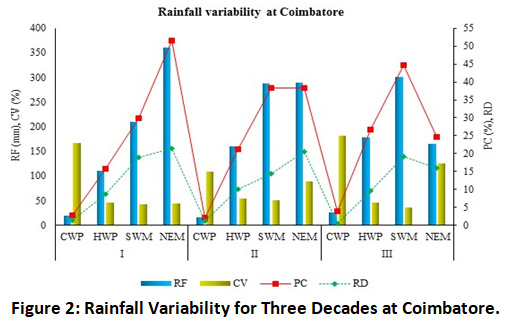 |
Figure 2: Rainfall Variability for Three Decades at Coimbatore. Click here to view Figure |
Ooty- High Altitude Zone
At Ooty, the annual rainfall received during the I decade was 1274.9 mm distributed in 88.4 rainy days and no significant reduction in rainfall and rainy days was recorded in the III decade (Fig 3). Alike Coimbatore, a higher percent contribution of SWM to annual rainfall and seasonality trend from I decade to III decades was observed at Ooty. The seasonal rainfall was found to be dependable in all the three decades which recorded less than 50 percent CV. The number of rainy days during SWM showed an increase from 45.4 during the I decade to 49.3 in III decades whilst the number of rainy days during the NEM showed a decrease from 24.8 to 19.2 during I to III decades.
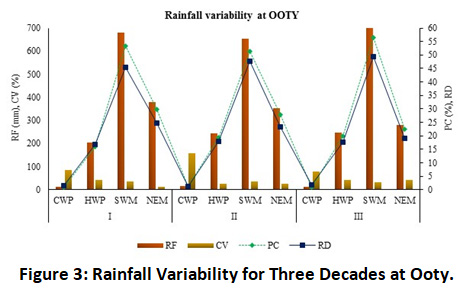 |
Figure 3: Rainfall Variability for Three Decades at Ooty. Click here to view Figure |
Cauvery Delta Zone-Trichy and Aduthurai
At Trichy, the annual rainfall received during the I decade was 883.5 mm distributed in 43 rainy days while it got reduced to 599.3 mm (32.2% decrease) spread in 34.2 rainy days in the III decade (Fig 4). Among the different seasons, the percent contribution from HWP to annual rainfall was found to be higher from I decade (10.8%) to III decades (18.3%). Both SWM and NEM showed a declining trend from I decade to III decades. Only the NEM rainfall was dependable during I decade with a CV of 41.2 percent. The CV was found to be more than 50 percent for all the seasons in the III decade which indicated the lower dependability of rainfall in the recent years. The number of rainy days was also found to be decreased from I decade to III decades in both the monsoon period. Since both monsoonal rainfalls are not dependable, for the non- delta blocks, special attention in the selection of crop and duration needs to be addressed to avert the weather vagaries during the cropping season.
 |
Figure 4: Rainfall Variability for Three Decades at Trichy. Click here to view Figure |
Aduthurai
At Aduthurai, the annual rainfall received during the I decade was 1010.8 mm distributed in 45.8 rainy days while it got increased to 1077.6 mm (6.2% increase) spread in 48.5 rainy days in the III decade (Fig 5). The same pattern registered in Coimbatore and Ooty for the higher percent contribution of SWM to annual rainfall and seasonality trend from I decade to III decades was observed at Authurai. The NEM recorded 47 percent of CV value in the I decade and the dependability of rainfall was higher while in the III decades, both SWM and NEM recorded less than 50 percent which indicated more dependability of seasonal rainfall. The number of rainy days during SWM showed an increase from 13.4 during I decade to 16 in III decades whilst the number of rainy days showed a decrease from 27.3 to 26 during I to III decades.
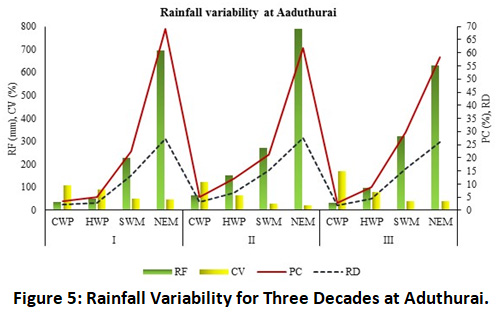 |
Figure 5: Rainfall Variability for Three Decades at Aduthurai. Click here to view Figure |
Southern Agro Climatic Zone-Killikulam
Killikulam
At Killikulam, the annual rainfall received during the I decade was 668.9 mm distributed in 41.2 rainy days while it got reduced to 475.8mm (28.9% decrease) spread in 31.3 rainy days in the III decade (Fig 6).Among the different seasons, the percent contribution from NEM to annual rainfall was found to be higher from I decade (63.6%) to III decades (72.9%). Both SWM and NEM showed a declining trend from I decade to III decades. Only the NEM rainfall was dependable with the CV of 47.1 percent during I decade and the CV was found to be 36.4 percent in the III decade for the NEM. The number of rainy days was found to be decreased from I decade to III decades in both the monsoon period.
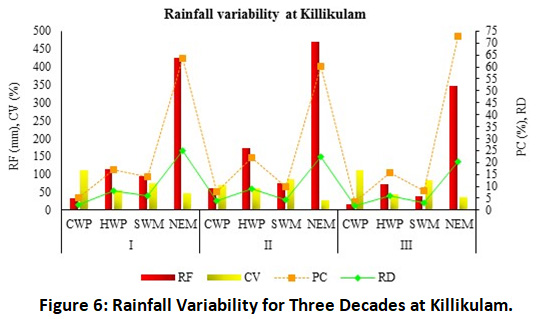 |
Figure 6: Rainfall Variability for Three Decades at Killikulam. Click here to view Figure |
Kovilpatti
At Kovilpatti, the annual rainfall received during the I decade was 707.0mm distributed in 42 rainy days while it got reduced to 604.8 mm (14.5% decrease) spread in 36.5 rainy days in the III decade (Fig 7).Among the different seasons, the percent contribution from SWM to annual rainfall was found to be higher from I decade (18.8%) to III decades (23.4%). The seasonal rainfall during SWM showed an increasing trend and NEM recorded a declining trend from I decade to III decades. Only the NEM rainfall was dependable with CV of 36.4 percent during I decade and in the III decade, each monsoonal rainfall was dependable with less than 50 percent CV. The number of rainy days was found to be decreased from I decade to III decades in both the monsoon period.
 |
Figure 7: Rainfall Variability for Three Decades at Kovilpatti. Click here to view Figure |
Arupukottai
At Arupukottai, the annual rainfall received during the I decade was 876.7mm distributed in 47 rainy days while it got reduced to 683.2 mm (22.1% decrease) spread in 41.3 rainy days in the III decade (Fig 8).Among the different seasons, the percent contribution from SWM to annual rainfall was found to be higher from I decade (29.0%) to III decades (32.2%). The seasonal rainfall during SWM showed an increasing trend and NEM recorded a declining trend from I decade to III decades. Only the NEM rainfall was dependable with the CV of 41.2 percent during I decade and in the III decade, each monsoonal rainfall was dependable with less than 50 percent CV. The number of rainy days was found to be decreased from I decade to III decades in both the monsoon period.
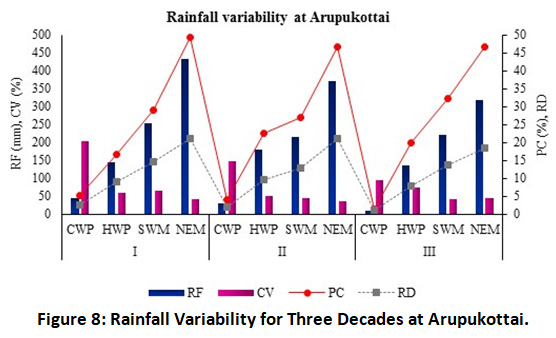 |
Figure 8: Rainfall Variability for Three Decades at Arupukottai. Click here to view Figure |
In the Southern Agro Climatic Zone, the reduction in NEM rainfall during the recent past entrusted the farmers to switch over to the SRI method of rice cultivation to reduce the water requirement under irrigated conditions. Under the rainfed condition, during the purattasipattam, the farmers choose to grow pulses, Maize, Chillies, Sorghum and Cotton are grown as in case of normal rainfall pattern while the declining rainfall trend made the farmers to minor millets (foxtail millet, little millet) to increase the rainfall use efficiency.
Since more area under rainfed agriculture pertains to Southern Agro Climatic Zone, the decreasing number of rainy days in all the seasons along with decreasing lifeline monsoon exhibits an alert in modifying the crop planning programme in those areas. In many parts of Asia, the frequency of heavy rain has increased, while the amount of rain and the number of wet days have reduced dramatically3,5.
Frequency of Rainfall Intensity for Different Locations of Tamil Nadu
The decadal frequency of rainfall intensity for different locations of Tamil Nadu is portrayed from Table 1a to 1g.
Table 1a: Frequency of Different Number of Rainy Days during Different Seasons at Coimbatore.
|
Season |
I |
II |
III |
|||||||||||||||
|
VLR |
LR |
MR |
RHR |
HR |
VHR |
VLR |
LR |
MR |
RHR |
HR |
VHR |
VLR |
LR |
MR |
RHR |
HR |
VHR |
|
|
CWP |
0.7 |
0.4 |
0.8 |
0 |
0.1 |
0 |
0.9 |
0.5 |
0.9 |
0.1 |
0 |
0 |
1.1 |
0.2 |
0.1 |
0.1 |
0.2 |
0 |
|
HWP |
2.6 |
4.8 |
3.3 |
0.5 |
0.1 |
0 |
5.8 |
3.6 |
4.5 |
0.7 |
0 |
0 |
5.2 |
3.1 |
4.4 |
0.9 |
0.3 |
0 |
|
SWM |
14.5 |
11.7 |
6.3 |
0.8 |
0.2 |
0 |
23.1 |
9 |
6.1 |
0.6 |
0.4 |
0 |
21.9 |
9.8 |
5.9 |
0.4 |
0 |
0 |
|
NEM |
7.7 |
8.8 |
10.2 |
1.6 |
0.9 |
0 |
10.1 |
5.2 |
8.7 |
2.5 |
0.6 |
0 |
9.9 |
5.7 |
7 |
1.7 |
0.2 |
0 |
Table 1b: Frequency of Different Number of Rainy Days during Different Seasons at Ooty.
|
Season |
I |
II |
III |
|||||||||||||||
|
VLR |
LR |
MR |
RHR |
HR |
VHR |
VLR |
LR |
MR |
RHR |
HR |
VHR |
VLR |
LR |
MR |
RHR |
HR |
VHR |
|
|
CWP |
1.3 |
1.3 |
1.1 |
0 |
0 |
0 |
1.1 |
1.0 |
0.9 |
0.1 |
0.1 |
0.0 |
1.9 |
1.0 |
1.0 |
0.0 |
0.0 |
0.0 |
|
HWP |
8.2 |
7.5 |
9 |
0.9 |
1 |
0.4 |
7.2 |
7.2 |
9.8 |
1.5 |
1.0 |
0.7 |
10.6 |
7.4 |
9.2 |
1.7 |
0.8 |
0.8 |
|
SWM |
22.7 |
20.1 |
19.8 |
2.9 |
2.5 |
5.6 |
21.4 |
21.3 |
22.0 |
2.9 |
1.5 |
2.6 |
25.2 |
22.1 |
22.9 |
2.3 |
1.5 |
2.8 |
|
NEM |
8.3 |
9.1 |
13.4 |
1.3 |
1.1 |
1.7 |
10.0 |
9.4 |
13.0 |
1.7 |
1.0 |
1.2 |
10.5 |
7.4 |
10.2 |
1.6 |
0.7 |
0.9 |
Table 1c: Frequency of Different Number of Rainy Days during Different Seasons at Trichy.
|
Season |
I |
II |
III |
|||||||||||||||
|
VLR |
LR |
MR |
RHR |
HR |
VHR |
VLR |
LR |
MR |
RHR |
HR |
VHR |
VLR |
LR |
MR |
RHR |
HR |
VHR |
|
|
CWP |
0.4 |
0.5 |
0.7 |
0.5 |
0 |
0 |
2.4 |
1.6 |
1.1 |
0.0 |
0.2 |
0.0 |
0.7 |
0.4 |
0.4 |
0.0 |
0.0 |
0.0 |
|
HWP |
2.7 |
3.5 |
3.8 |
0.6 |
0.9 |
0 |
6.4 |
4.2 |
5.8 |
1.5 |
0.9 |
0.0 |
2.9 |
3.1 |
4.4 |
1.1 |
0.7 |
0.0 |
|
SWM |
4.5 |
7.8 |
13.1 |
4.2 |
0.9 |
0 |
8.7 |
10.0 |
12.9 |
3.6 |
1.3 |
0.0 |
5.6 |
8.5 |
10.5 |
1.8 |
0.4 |
0.0 |
|
NEM |
9.5 |
14.9 |
20.7 |
4.1 |
1.5 |
0.7 |
14.5 |
14.7 |
20.5 |
3.2 |
1.6 |
0.5 |
9.5 |
9.6 |
14.5 |
2.9 |
1.1 |
0.4 |
Table 1d: Frequency of Different Number of Rainy Days during Different Seasons at Aduthurai.
|
Season |
I |
II |
III |
|||||||||||||||
|
VLR |
LR |
MR |
RHR |
HR |
VHR |
VLR |
LR |
MR |
RHR |
HR |
VHR |
VLR |
LR |
MR |
RHR |
HR |
VHR |
|
|
CWP |
2.4 |
0.9 |
1.3 |
0.2 |
0 |
0 |
1.9 |
1.5 |
1.2 |
0.3 |
0.2 |
0.2 |
1.5 |
0.9 |
0.9 |
0.2 |
0 |
0 |
|
HWP |
1.4 |
0.9 |
1.7 |
0.2 |
0 |
0 |
3.2 |
1.9 |
3.8 |
0.6 |
0.1 |
0.4 |
2.1 |
1.3 |
2.9 |
0.1 |
0.2 |
0 |
|
SWM |
7.6 |
5.1 |
6.7 |
1.3 |
0.5 |
1 |
7.6 |
4.7 |
8 |
1.4 |
0.6 |
0.3 |
11.2 |
4.9 |
8.5 |
1.9 |
0.7 |
0 |
|
NEM |
12 |
9.8 |
12.8 |
2.2 |
1.9 |
1.2 |
9.4 |
6.7 |
14 |
2.7 |
2.5 |
1.2 |
6.3 |
6.4 |
13.7 |
4.5 |
1.3 |
0.1 |
Table 1e: Frequency of Different Number of Rainy Days during Different Seasons at Killikulam.
|
Season |
I |
II |
III |
|||||||||||||||
|
VLR |
LR |
MR |
RHR |
HR |
VHR |
VLR |
LR |
MR |
RHR |
HR |
VHR |
VLR |
LR |
MR |
RHR |
HR |
VHR |
|
|
CWP |
1 |
0.8 |
1.3 |
0.2 |
0 |
1 |
0.9 |
1.2 |
2.4 |
0.4 |
0 |
0 |
0.3 |
0.8 |
0.9 |
0 |
0 |
0 |
|
HWP |
1.6 |
3.7 |
3.8 |
0.3 |
0 |
1.6 |
1.6 |
3 |
5.1 |
0.5 |
0 |
0 |
1.3 |
3.3 |
2.4 |
0.2 |
0 |
0 |
|
SWM |
2.7 |
2.7 |
2.9 |
0.3 |
0.1 |
2.7 |
1.8 |
1.5 |
2.3 |
0.6 |
0 |
0 |
2 |
1.6 |
1.4 |
0.2 |
0 |
0 |
|
NEM |
4.6 |
9.3 |
12.5 |
2.1 |
0.1 |
4.6 |
3.8 |
6.6 |
11.9 |
2.7 |
0 |
0 |
7.4 |
7.1 |
10.9 |
1.8 |
0 |
0 |
Table 1f: Frequency of Different Number of Rainy Days during Different Seasons at Arupukottai.
|
Season |
I |
II |
III |
|||||||||||||||
|
VLR |
LR |
MR |
RHR |
HR |
VHR |
VLR |
LR |
MR |
RHR |
HR |
VHR |
VLR |
LR |
MR |
RHR |
HR |
VHR |
|
|
CWP |
0.8 |
0.9 |
0.9 |
0 |
0.2 |
0.1 |
0.7 |
1 |
0.7 |
0.3 |
0 |
0 |
0.7 |
0.7 |
0.4 |
0 |
0 |
0 |
|
HWP |
2.7 |
3.3 |
4.8 |
0.5 |
0.1 |
0 |
2.5 |
3.1 |
5.6 |
0.8 |
0.3 |
0 |
1.9 |
3.6 |
3.4 |
0.8 |
0.2 |
0 |
|
SWM |
4.9 |
5.7 |
6.9 |
1.7 |
0.4 |
0 |
4 |
4 |
7.3 |
1.3 |
0.2 |
0 |
3.6 |
5.7 |
6.7 |
0.9 |
0.5 |
0 |
|
NEM |
7.4 |
7.5 |
11.2 |
1.9 |
1.1 |
0.1 |
4.1 |
8.1 |
10.2 |
1.9 |
0.8 |
0 |
5.6 |
6.5 |
9.7 |
1.9 |
0.3 |
0 |
Table 1g: Frequency of Different Number of Rainy Days during Different Seasons at Kovilpatti.
|
Season |
I |
II |
III |
|||||||||||||||
|
VLR |
LR |
MR |
RHR |
HR |
VHR |
VLR |
LR |
MR |
RHR |
HR |
VHR |
VLR |
LR |
MR |
RHR |
HR |
VHR |
|
|
CWP |
5.3 |
2.7 |
1.3 |
0.3 |
0 |
0 |
4.2 |
1.5 |
2.4 |
0.0 |
0.0 |
0.0 |
3.0 |
1.2 |
1.2 |
0.0 |
0.0 |
0.0 |
|
HWP |
5.6 |
6.7 |
8.9 |
1.3 |
0 |
0 |
11.3 |
8.0 |
10.9 |
0.9 |
0.4 |
0.0 |
7.8 |
6.0 |
7.6 |
1.2 |
0.0 |
0.0 |
|
SWM |
10.9 |
9.6 |
7.6 |
1.7 |
0.4 |
0.0 |
11.8 |
6.2 |
7.8 |
1.5 |
0.2 |
0.0 |
10.6 |
4.0 |
6.6 |
1.4 |
0.6 |
0.0 |
|
NEM |
17.5 |
14.4 |
19.6 |
4.2 |
0.9 |
0.0 |
20.7 |
12.2 |
22.5 |
3.4 |
1.8 |
0.0 |
21.4 |
13.0 |
19.6 |
2.0 |
0.6 |
0.0 |
Total number of RD was found to be 76, 83.3 and 78.1 during I, II and III decadal period for Coimbatore. More number of VLR (14.5-I, 23.1-II & 21.9-III) was observed during SWM and no HR incidence was reported in the recent decade. In NEM, VLR was found to be increased from 7.7- I to 9.9 in the III decade and other intensity of rainfall was found to be decreased in the recent decade.
In Ooty, the rainfall intensity classification from VLR to VHR was reported during both SWM and NEM respectively. Light and Moderate Rainfall intensity has been increased while Heavy and Very Heavy Rainfall intensity got decreased during SWM from I to III decade. Light to very heavy rainfall intensity got reduced during NEM except VLR intensity.Due to a rise in the frequency of extreme events in the global warming age, there is a growing trend in the irregularity of daily rainfall activity9.
Total number of RD was found to be 95.5, 115.7 and 78.5 during I, II and III decadal period for Trichy. Since, the rainfall intensity categories varying from LR to VHR reduced in both SWM and NEM from I decade to III decade, the total number of rainy days decreased in the III decade.Total number of RD was found to be 71.1, 74.4 and 69.6 during I, II and III decadal period for Aduthurai. The total number of rainfall intensity values were found to be more or less equal during SWM and NEM season, minimal variation was found at Aduthurai location.
Total number of RD was found to be 50, 46.3 and 41.6 during I, II and III decadal period for Killikulam. Heavy and Very High Rainfall intensity was absent in the II and III decades.Total number of RD was found to be 63.1, 56.9 and 53.1 during I, II and III decadal period for Arupukottai. During NEM, LR and MR was found to be lower when compared with I and III decade.Total number of RD was found to be 118.9, 127.5 and 107.8 during I, II and III decadal period for Kovilpatti. Since, total number of rainfall intensity values were found to be more or less equal during SWM and NEM season, minimal variation was found at Kovilpatti. The frequency of rainfall intensity revealed that except Ooty, the number of Heavy Rain (HR) to VHR(VHR) was found to be meagre to absent in most of the studied locations. The rainfall intensity frequency for Coimbatore inferred similar findings1.
Conclusion
It's worth looking at the frequency and intensity trends separately since it's feasible that the number of extreme occurrences will rise without a commensurate rise in the intensity of each event. The results of the study indicated that an increasing trend in SWM rainfall was observed in Coimbatore (209.3 to 300.6mm), Ooty (681.4 to 703.1mm), Aduthurai (227.8 to 320.6mm), Kovilpatti (132.8 to 141.3 mm) while decreasing trend was observed in rest of the places. A decreasing trend was reported in general for all the places during NEM. Decreasing trend in number of rainy days was registered in Kovilpatti, Virudhunagar and Killikulam that exhibits an alert in modifying the crop planning programme in those areas. The frequency of rainfall intensity revealed that except Ooty, the number of Heavy Rain (HR) to VHR(VHR) was found to be meagre to absent in most of the study locations. The daily rainfall analysis would also pave a way to fix the reasonable premium and related payout structure for the rainfall-based crop insurance products in the specific location.
Conflict of Interest
There is no conflict of interest in the manuscript.
Acknowledgement
The authors would like to thank Agro Climate Research Centre, Tamil Nadu Agricultural University for the support to carry out the research in a successful way. The author is also profoundly grateful for other research stations for sparing the valuable meteorological data.
Funding Source
There is no funding or financial support for this research work.
References
- Arthi Rani B, Manikandan N, Maragatham N. Trend analysis of rainfall and frequency of rainy days over Coimbatore. MAUSAM. 2014;3, 379-384.
- Bandyopadhyay J, Perveen SA.Scrutiny of the justifications for the proposed interlinking of rivers in India. Interlinking of Rivers in India: Overview and Ken-Betwa link,2006, 23.
- Dash SK, Jenamani RK, Kalsi SR, Panda SK. Some evidence of climate change in twentieth-century India. Climatic Change. 2007; 85, 299-321.
CrossRef - Gajbhiye S, Meshram C, Singh S K, Srivastava PK, Islam T. Precipitation trend analysis of Sindh River basin, India, from the 102?year record (1901–2002). Atmospheric Science Letters, 2015; 17(1), 71-77.
CrossRef - Kumar V, Jain SK, Singh Y. Analysis of long-term rainfall trends in India.Hydrological Sciences Journal–Journal des Sciences Hydrologiques. 2010; 55(4), 484-496.
CrossRef - Langhans C, Govers G, Diels J, Clymans W, Van den PutteA. Dependence of effective hydraulic conductivity on rainfall intensity: loamy agricultural soils. Hydrol. Processes. 2010. 24, 2257-2268.
CrossRef - Meshram SG, Singh VP,Meshram C. Long-term trend and variability of precipitation in Chhattisgarh State, India.Theoretical and Applied Climatology, 2017;129(3-4).
CrossRef - Mirhosseini G, Srivastava P, Stefanova L. The impact of climate change on rainfall intensity–duration–frequency (IDF) curves in Alabama. Reg. Environ. Change 13 (Suppl. 1). 2013; S25-S33.
CrossRef - Nandargi S, Mulye SS. Relationships between Rainy Days, Mean Daily Intensity, and Seasonal Rainfall over the Koyna Catchment during 1961–2005. The Scientific World Journal. 2012; 894313-10.
CrossRef - Prasada Rao GSLHV, Rao GSN, Rao VUM. Climate change and agriculture over India. PHI Learning Private Limited. New Delhi. 2010; pp. 1-42.
- Sen Roy S. Balling RC. Trends in extreme daily precipitation indices in India. Int. J. Climatol. 2004;24 457-466.
CrossRef - Srivastava PK, Mehta A, Gupta M, Singh SK, Islam T. Assessing the impact of climate change on Mundra mangrove forest ecosystem, Gulf of Kutch, western coast of India: a synergistic evaluation using remote sensing. Theoretical and Applied Climatology, 2015;120(3-4), 685-700.
CrossRef - Vinay K, PrathipatiNaidu CV, Prasanna Konatham. Inconsistency in the frequency of rainfall events in the Indian summer monsoon season. International Journal of Climatology. 2019; 39,13.
CrossRef - Walthall CL, Hateld J, Backlund P, Lengnick L, et al. Climate Change and Agriculture in the United States: Effects and Adaptation. USDA Technical Bulletin. Washington, DC. 2012;186 pages






